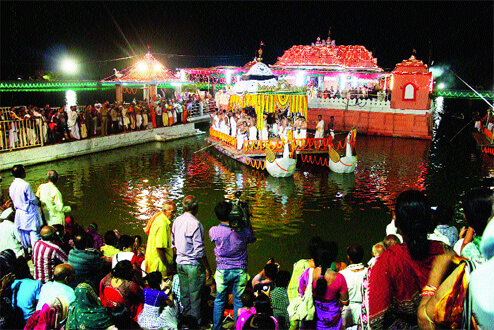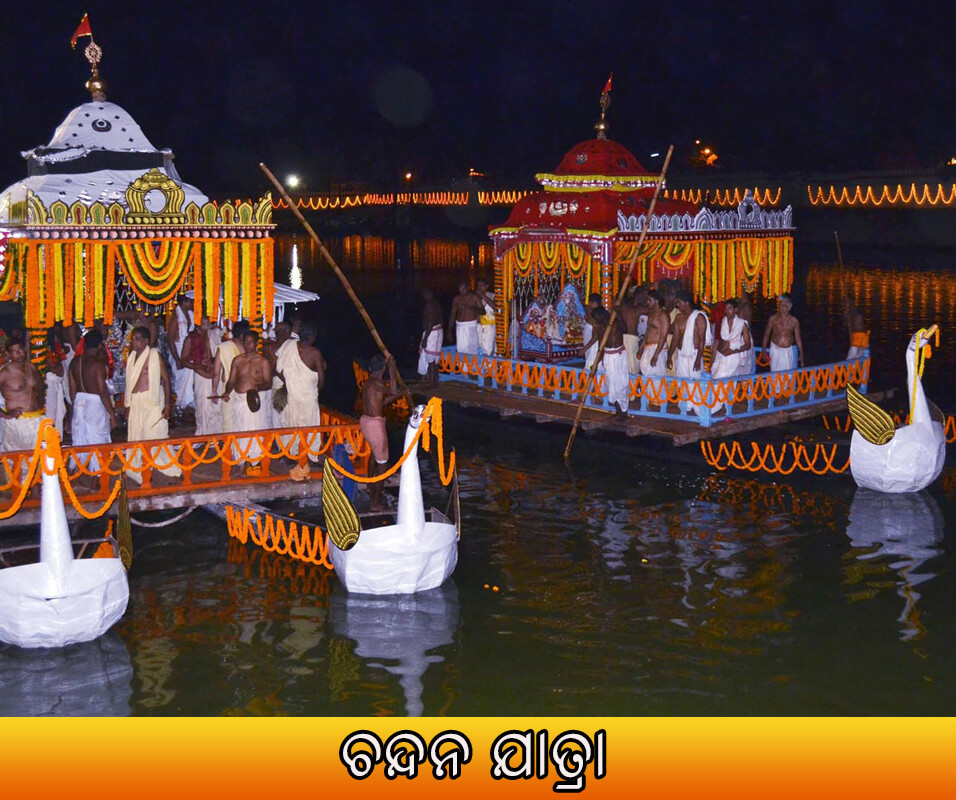
The Chandanayatra is the longest-celebrated festival in the temple. It lasts for a total of 42 days from Baishakh Shukla III (Akshay III) to the eldest Shukla Chaturdashi (the day before the full moon). It is celebrated for 21 days from Akshay Tritiya to the eldest Krishna Ashtami as the outer sandalwood pilgrimage in the Narendra Puskarani and as the inner sandalwood in the temple for the next 21 days (the eldest Shukla Chaturdashi). According to mythology, Narasimha Deb organized the journey in the true age. During the Dwapar period, Panchupandava gave his true identity to the great king after his disappearance. Lord Krishna agreed to fulfill his wishes as he wished to see the great King Krishna and Balarama in the form of Ramakrishna with Panchupandava. A huge reservoir was then built to build the Water Kelly Mandapa. The festival was held in the city of Achalavya and Vibhastu. Probably a factor as to why they’re doing so poorly. Madan Mohan and Ramakrishna travel to the Panchupandava for water sports. It is believed to have originated in the thirteenth century AD in the name of Chandan Yat. Thousands of temples in India are hot on a hot day, sandalwood, but it is known only in Odisha as a special pilgrimage and festival. The bathing full moon lasts for 42 days from Baishakh Shukla III. The fragrance is divided into three parts: watermelon and intestinal sandalwood. Kabisamrat, Deenbandhu Das, Atibadi Jagannath Das, Kabisurya, Banamali, Birkishore and other leading comedians have composed songs about the journey. For example, Banamali Das’s work is well-known in the villages of Odisha for its vivid descriptions of the Chandan Yatra under 300 years old.
According to the Skandapurana, the Bamdev Samhita, and the Sushruta Samhita, the pilgrimage to various parts of Odisha is celebrated over the last 500 years in connection with the Deva idol, whose original Purushottama Prabhu was intended to keep him entertained by cold treatment in his sleep. But for the sake of the “joy of the people,” it is the creation, the state, and the spread of the joy of the people. According to historical records, the Chandan Yatra dates back to the time of the kings of the Ganges. During the reign of King Narasimha II, Narendra Mohapatra dug a pond. King Chodgangdev was sailing Thakur in the Jagannath Ballabh Bent pond. Narendra Deva, the brother of Gajapati Kapilendradev, is said to have been excavated in memory of his 14 sons in a battle. Later the sandalwood journey began here. Three moving statues of octagonal metal from Madanmohan, Krishna, Rama (Balaram) and two moving statues of Madanmohan, Krishna and Ratnasinghasan from the south (the house at the mouth of the Beharan Gate to the south of Ansar’s house) share the golden idol of Lakshmi and the silver idol of Saraswati.
In Chandan Yatra Patuar, there are a total of ten moving statues and planes. Madanmohan, Sridevi (or Lakshmi) and Bhudevi (or Saraswati, Bishwadhatri) are the most beautiful planes. On the back of the plane, Balarama and Krishna ascend the Palinkiti, and on the other five planes, the five Mahadevs, known as the Panchupandavas, ascend the Sriloknath, Srimarkandeshwar, Srinilakantheshwar, Sreejambeshwar and Srikapalamochan. A chamundia is made in the Narendra Puskarini clan. At the bottom of the chandelier, ten moving idols are placed and bathed in fragrant water in a silver bowl. A pair of writing boats is used to create two pressures. The stresses are exacerbated by the scars. Madanmohan, Sridevi, Bhudevi, Balarama and Krishna sit on a silver-carved throne under one pressure. Under the other pressure, the great deities known as Basanti Panchupandava. The idols are accompanied by worshipers such as Pujapanda, Sinhari, Garabadu, Suarabadu, Patribadu, Hadap and Khuntia. The two stresses return to Narendra’s water. For bathing, fragrant water is used in three basins using sandalwood, camphor, musk, nutmeg, mullein, champa, jui, sugandharaja, roses and so on. The idols are immersed in that pool. Madanmohan is dressed up after being immersed in water. Twenty-one to twenty days after the Chandan Yatra, Madan Mohan wears a new costume every day. Many of these costumes are held to commemorate Krishnalila’s death. The costumes were as follows:
Akshay III: Natbar Besh (Tribhanga dancing Sri Krishna)
Baishakh Shukla Chaturthi: Harijanma Besh (river cross by Basudev)
Baishakh Shukla Panchami: Rajadhiraja Besh (Dwarkadhish)
Baishakh Shukla Sixth: Khatdoli Besh (Doli Khel in Kunj)
Baishakh Shukla Saptami: Gomti Krishna Besh (Brahmagopala Besh)
Baishakh Shukla Ashtami: Batsacharan (Gocharan Gopal)
Baishakh Shukla Ninth: Batsaharan Besh (Brahma Bimohan Leela)
Vaishakh Shukla Dashami: Aghasur’s slaughter is beautiful (Aghasur’s slaughter by Krishna)
Baishakh Shukla Ekadashi: Chakra Narayan Besh (Chakradhari Krishna)
Baishakh Shukla Dwadashi: Nabkeli Besh (Yamuna Keli)
Baishakh Shukla Triodashi: Rahasamandali Besh (Race Sports)
Baishakh Shukla Chaturdashi: (Date of birth of Narsingh) This day is not dressed up.
Baishakh Purnima: Kandarpa Rath Besh (Krishna surrounded by chariots by Gopangana)
Baishakh Krishna Pratipada: Sadbhuj Gaurang Besh (Kali Yuga Premavatar)
Baishakh Krishna II: Raghunath Besh (Shriram)
Baishakh Krishna III: Giri Puja Besh (Govardhan Puja)
Baishakh Krishna Chaturthi: Giriteka Besh (Govardhan Dhar)
Baishakh Krishna Panchami: Clothing Discovery
Baishakh Krishna Seshti: Chintamani Krishna Besh / Madan Mohan Besh (Muralidhar)
Baishakh Krishna Saptami: Gaj rescue costume (to protect the yard from crocodiles)
Baishakh Krishna Ashtami: Kunjbihari Besh (playing doli in Nikunj)
After a while, the night pressure is done. A single-boat boat with two stresses at night is used in this port. The Bajantri boat has a bell, a trumpet, and a Telingi baja player. A serviceman with them is holding a fountain of Polish oil. It is customary for the day to end in one cycle, while the three at night. For the water of Thakur after the deities idolized near the chakra of Narendra Puskarini, give the water to Thakur, start the pressure, start the pressure, end the pressure, give the sandalwood tank, get out of the sandalwood tank, sadhabesh, shitalbhog, besh, mandua bhog, give out BJ, bidamanohi, bandapanohi About 41 different types of servants are required daily to perform the rituals of stress, beginning and end of stress, and Bahuda BJ. The trip is beautiful with music and dancing. The last day of the pilgrimage is celebrated by the Virgin Mary. The Bhavri Yatra is held on the last day of the 21-day outdoor sandalwood procession of Shri Gannath Mahaprabhu. According to tradition, Narendra Puskarini is performed in a colorful procession to Sriloknath, Srimarkandeshwar, Srinilakantheshwar, Sreejambeshwar and Srikapalmochan, including Madanmohan, Balarama, Krishna, Sridevi and Bhudevi. On Bhavri day, only daytime pressure, not nighttime pressure, 21 days of Narendra Pokhari are lit around the lamppost. The Thakurs make the shrine a bahudabije after playing 21 rounds of pressure in the Narendra pond.
Traditionally, after the morning incense of Bhavri, the devotees go to the chariot yard at the behest of the Sreejivas. There, after receiving the orders, the Maharana’s servants connect the two letters to the three letters of the three letters under construction. The day after the pilgrimage, the Sreejimas have a yellow water policy. When the Thakurs reach Narendrapuskarini by plane, only Madanmohan, Sridevi and Bhudevi play turmeric by defeating Chapadanga. After the outer sandalwood procession, the temple is completed for 21 days during the inner sandalwood process. In addition, the water sports policy of the Lord is performed in the eldest Krishna Ekadashi, Sabitri Amavasya, Shitalashti and Rukmini Haran Ekadashi. In it, Srimadanmohan, Sridevi and Bhudevi go to the water sports pavilion near Rohinikunda and spend their time there in the fragrant waterpark.
There is a 8-foot-wide and 12-foot-long ‘sandalwood house’ near the Muktimandapa in the temple. Every day there is sandalwood for the devotees. Ghotari servants use the three stones in the sandalwood house to grind the sandalwood. A total of seven goths are wearing sandals. On normal days, the Ghotari servants carry about 442 grams of sandalwood, while the sandalwood weighs about 1 kg. After offering the evening meal, the Thakurs are taken down and sandalwood is applied to the arms and limbs of the three Thakurs. Thakur is sandwiched to remove the trinity of the world (natural, spiritual and spiritual).
After the morning incense, the door to victory is closed after offering the umbrella. Throwing a wooden horse in front of the deities, three of the servants scattered the deities in the hammer. After a while, the skin of the skin is closed, and the mixture of sandalwood, camphor, hair, chua, etc. is applied to the body of the deity. The florists do this. Every day three special ornaments are used in the form of cheetahs, guna and lipsticks (respectively, ornaments on the forehead, NASA face) and in the form of special flower ornaments. Alka (flower garlands adorned on the forehead) garlands are made by the florists of the temple. The wreath extends on both sides of the idol triangle (both sides of the head) and one flower extends on both sides of the entire caliber. The chariots (four small stacks are folded together) are about 20 feet long. These necklaces are provided by Raghav Das Math.In addition to the Vishnu temple, the Chandan Yatra is celebrated at the Peeth of Sharla Devi in Jhankar and at the Lingaraj Temple in Bhubaneswar. Sandalwood pilgrimage is common in all ancient temples.
Comments
comments
